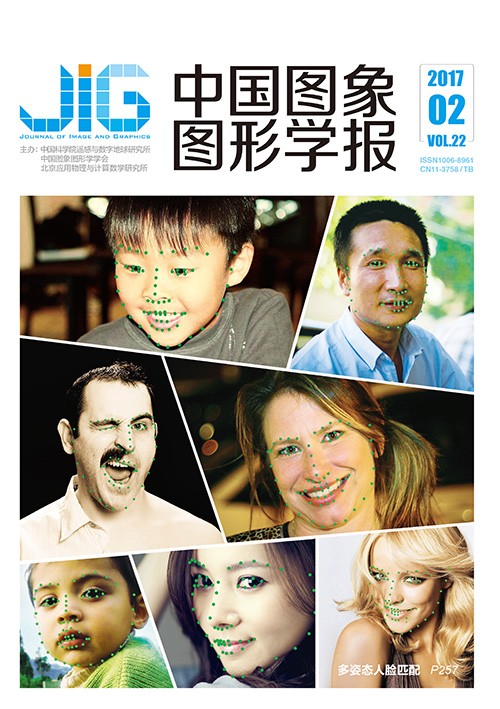
利用区域信息融合混合活动轮廓模型的 河流遥感图像分割
韩斌1, 吴一全1,2,3, 宋昱1(1.南京航空航天大学电子信息工程学院, 南京 211106;2.黄河水利委员会黄河水利科学研究院水利部黄河泥沙重点实验室, 郑州 450003;3.哈尔滨工业大学城市水资源与水环境国家重点实验室, 哈尔滨 150090) 摘 要
目的 河流遥感图像是背景复杂的非匀质图像,利用传统的活动轮廓模型进行分割往往不够准确。针对这一问题,提出了基于区域信息融合的混合活动轮廓模型来分割河流遥感图像。方法 该混合模型将Chan-Vese(CV)模型和基于交叉熵的活动轮廓模型的外部能量约束项相结合,并赋予归一化调节比例系数。通过计算轮廓曲线内外区域像素灰度的方差和交叉熵,指导曲线逼近目标边缘。为了加速混合模型的演化,引入曲线内外区域像素灰度的类内绝对差,取代原有的内外区域能量权值,以提高混合模型的分割效率。结果 大量实验结果表明,相较于CV模型、测地线模型、基于交叉熵的活动轮廓模型、CV模型和测地线模型的混合模型以及局部全局灰度拟合能量模型(LGIF),本文混合模型分割河流遥感图像的灵敏度和上述方法都接近于100%,准确率大幅提升,在90%以上,虚警率则下降了约50%,且所需迭代次数和运行时间更少。结论 本文提出的混合模型主要适用于具有一定对比度的河流遥感图像,在分割性能和分割效率两个方面,都有明显的优势。
关键词
Segmentation of remote sensing images of rivers utilizing a hybrid active contour model with regional information fusion
Han Bin1, Wu Yiquan1,2,3, Song Yu1(1.College of Electronic and Information Engineering, Nanjing University of Aeronautics and Astronautics, Nanjing 211106, China;2.Key Laboratory of Yellow River Sediment of Ministry of Water Resources, Yellow River Institute of Hydraulic Research, Yellow Water resources Commission, Zhengzhou 450003, China;3.State Key Laboratory of Urban Water Resources and Environment, Harbin Institute of Technology, Harbin 150090, China) Abstract
Objective Remote sensing images of rivers are heterogenous and the intensities of the area inside the background are complicated. Drawing upon the traditional active contour models to segment the remote sensing images of rivers is ineffective. A hybrid active contour model with regional information fusion is proposed to improve the river extraction accuracy in remote sensing images of rivers to address this problem. Method The hybrid model combines the external region energy constraint terms of the CV model and the cross entropy-based active contour model. The different normalized ratio coefficients are incorporated into the above external region energy constraint terms. During evolution, both the variance and cross entropy information of the pixel grayscale values in the internal and external areas of the contour curve are calculated to guide the curve to approach the object edges. Moreover, the within-cluster absolute differences of the internal and external areas of the curve are incorporated to adaptively adjust the internal and external area energy weights instead of the original area energy weights and accelerate the hybrid model evolution. The proportion of the internal and external area energy can change continuously with the curve evolution, which ultimately improves the segmentation efficiency of the proposed model. Result Experiments are conducted on a large quantity of remote sensing images of rivers. The sensitivity of the proposed hybrid model is at almost 100 percent, which is similar to those of the CV model, geodesic active contours model, cross-entropy based active contour model, a hybrid model based on the CV and geodesic active contours models, and the LGIF model. Its accuracy is much higher than the other models, which exceeds 90 percent. False alarm incidents decreased by 50 percent. The iterative number and running time of the proposed model are also less than those of the other methods. Conclusion This study proposes a novel hybrid active contour model with regional information fusion to achieve accurate river extraction in remote sensing images of rivers, which has a relative contrast between the area inside the background and area inside the river. The proposed model utilizes two area description criteria that are within-cluster variance and cross entropy to guide the curve evolution. This approach is more accurate than using a single-area description; hence, it can obtain better segmentation results. Moreover, the internal and external area energy weights of the proposed model can be adjusted adaptively, which leads to the rapid curve evolution. Extensive experiment results show that the proposed hybrid model not only obtains higher accuracy and sensitivity but also records fewer false alarms than the CV model, geodesic active contours model, cross entropy-based active contour model, a hybrid model based on the CV and geodesic active contours models, and the LGIF model. The proposed model has clear advantages in both segmentation performance and segmentation efficiency.
Keywords
remote sensing image of river image segmentation regional information fusion hybrid active contour model within-cluster absolute differences adaptive weights
|



 中国图象图形学报 │ 京ICP备05080539号-4 │ 本系统由
中国图象图形学报 │ 京ICP备05080539号-4 │ 本系统由